

Green, Green Grass of
Jejudo Island
All the Colors of Spring in Jejudo Island
Jejudo Island is a volcanic island of many colors, from the yellow of canola blossoms, to green barley fields, orange mandarins, emerald green waters, royal pink azaleas, red photinias, purple hydrangeas and shinning silver grass, all set against the shade of the mountain and volcanic cones. April on Jejudo Island is filled with greens and yellows, the colors of spring. The yellow canola blossoms that dot the fields like a painting, and the deep-green barley sprouting from the ground, create scenery that's best enjoyed while walking slowly with many stops in between.
Written by Ahn Min-joo, Broadcasting writer Photographed by Studio Kenn
Illustrated by Hagogo

Sanbangsan Mountain, Where
Emerald Sea Meets Yellow Blossoms
Under a Black Volcano
Drive along the coastal roads on Jejudo Island’s southwest coast and you will see Sanbangsan Mountain, a landmark in Sagyeri, Andeok-myeon. Sanbangsan Mountain is large enough to be seen from any part of southwest Jejudo Island, and is all the more eye-catching as it rises high above the ground from the surrounding flatlands.
According to legend, Sangbangsan Mountain was created when Seolmundae Halmang, a mountain god, was angered and tore off and flung away the tip of Hallasan Mountain, the much larger former volcano in the center of Jejudo Island. Sanbangsan Mountain has a unique air of mystery and wonder, being made of the same rock as Hallasan Mountain. It has been designated as Korea’s Scenic Site No. 77, Natural Heritage Site No. 376, and is part of Section No. 10 of the provincial network of walking trails.
Sanbangsan Mountain’s canola blossom fields are a truly special destination where one can enjoy the yellow blossoms set against the harmony of the clear blue skies of Jejudo Island, the emerald green sea and the black rock of Sanbangsan Mountain.
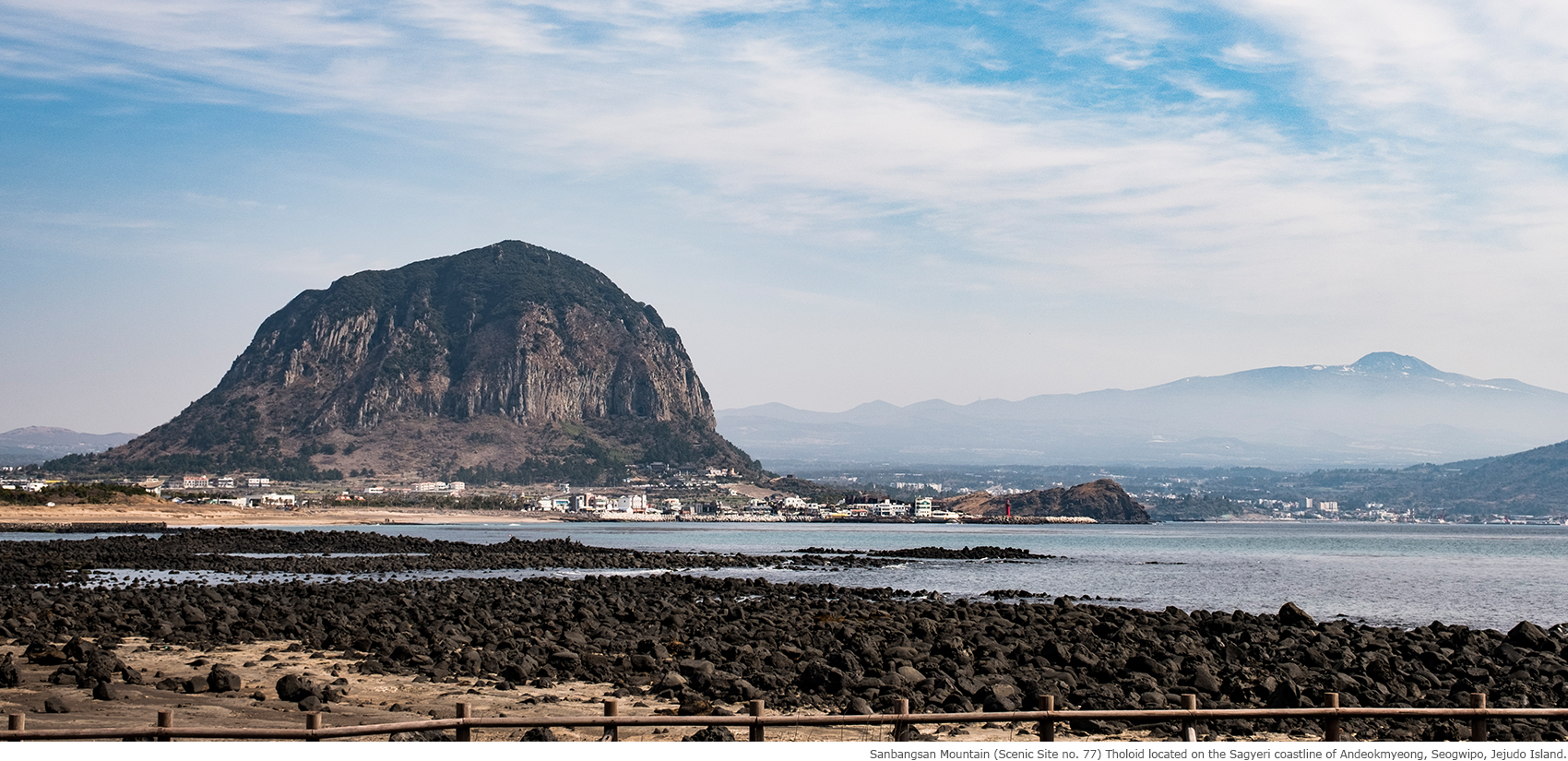
Sanbanggulsa Grotto
At the foot of Sanbangsan Mountain is the Sanbanggulsa Grotto, a small grotto temple. Here, one can have the unique experience of looking over the sea from a tiny temple situated on the majestic Sanbangsan Mountain.
Waterdrops fall here all day long, regardless of the weather. These droplets are sometimes called the tears of Sanbangdeok, the goddess of Sanbangsan 1Mountain.
Yongmeori Beach
Yongmeori Beach -- literally, “Dragon’s Head Beach” -- is located right in front of Sanbangsan Mountain. It was given its name because of the shape of a rock there, which is said to resemble the head of a dragon diving into the sea. Public binoculars are set up at the viewing platform, allowing visitors to see Sanbangsan Mountain and the surrounding outcroppings. Walking along the coastal walking path in the warmth of the spring sun, one can take in the splendor of Sanbangsan Mountain, canola blossoms and the endless ocean.
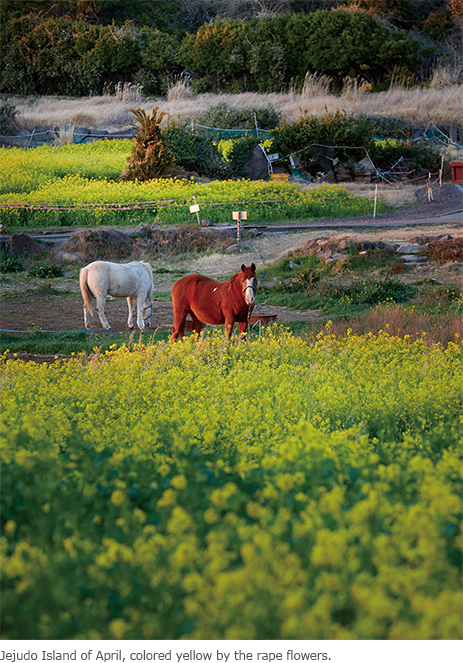
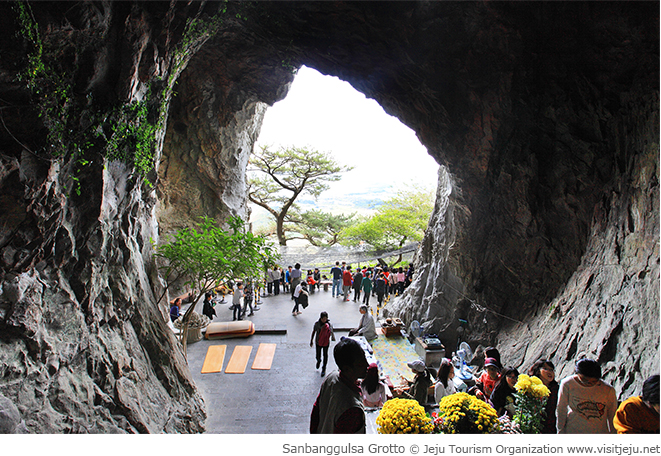
Hamel’s Ship Exhibition Hall
Hamel’s Ship Exhibition Hall is located at the foot of Sanbangsan Mountain, near Yongmeori Beach.
Hamel’s Ship Exhibition Hall was built to commemorate Hendrick Hamel (1630-1692), the first Westerner to provide a first-hand account of Joseon. He was shipwrecked on the beach at the base of Sanbangsan Mountain in 1652, and he lived as a prisoner in Joseon for 13 years. Upon escaping, he published “Hamel’s Journal and a Description of the Kingdom of Joseon.” The exhibition hall is built in the shape of Hamel’s wrecked ship, and tells the story of Hamel’s life in Joseon over those many years.
Sanbangsan Mountain Hot Springs
The Sanbangsan Mountain Hot Springs in Sagye-ri, Andeok-myeon, Seogwipo-si, are carbonated hot springs, a rare phenomenon on the Korean Peninsula.
The water used to be called gumyeongsu, which has two meanings. One, it means “water of the pigeon’s call,” and, two, it means “lifesaving water.” Legend has it that people were cured of diseases after drinking the water here, and so to this day people still flock here in the hopes that it may help their hypertension or heart disease.
This may not be just a tall tale, as the carbon in the water gets absorbed through the skin, stimulating the capillaries and expanding the blood vessels. This ultimately helps to lower the blood pressure and to reduce the load on the heart. Unlike ordinary hot springs, the water here is only lukewarm, which feels odd at first. However, one can soon feel its effects, including relief of fatigue or sore muscles. There are open-air baths that allow bathers to enjoy the breeze and the views of Sanbangsan Mountain while in the water.


Jejudo Island Spring Flowers
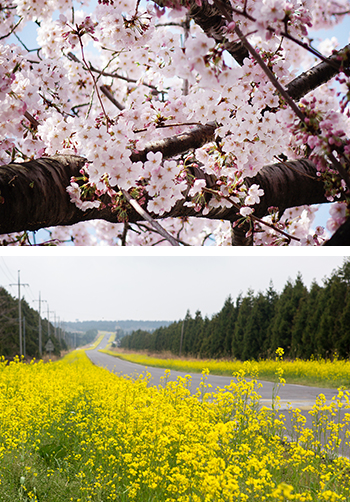
-
Cherry blossom streets
- Entrance of Jejudo Island National University
- Gwaneumsa Temple
- Wimi-ri Loop Drive
- Jeonnong-ro Seosara Cherry Blossom Street
- Noksan-ro Cherry Blossom Street (With Canola Flowers)
- Sinsan Park
- Sarabong Peak, Byeoldobong Peak
- Aewol Jangjeon-ri Cherry Blossom Street
Camellia flower streets
- Hallasan Dullegil, located 600-800 m above sea level, is a forest trail that stretches for 80 km in Hallasan National Park. The five courses are the Camellia Trail, Doloreum Trail, Suak Trail, Saryeoni Forest Trail, and Cheona Forest Trail. The 13.5 km Camellia Trail connects Muobeopjeongsa Temple to Donnaeko Trail. This trail, found in the heart of a subtropical forest, is where you can enjoy the brilliant red of camellia flowers in winter as well as spring.
Canola flower streets
- Sanbangsan Mountain Yongmeori Geo Trail Course A
- Hamdeok Seoubong Dullegil Road
- Stretch of canola flowers along Hwasunseodong-ro(5 km)
- Seogwipo Yuchae (Canola) Flower International Walking Festival
- Canola flower field near Gwangchigi Beach, Olle Trail Route 1
Trip Points
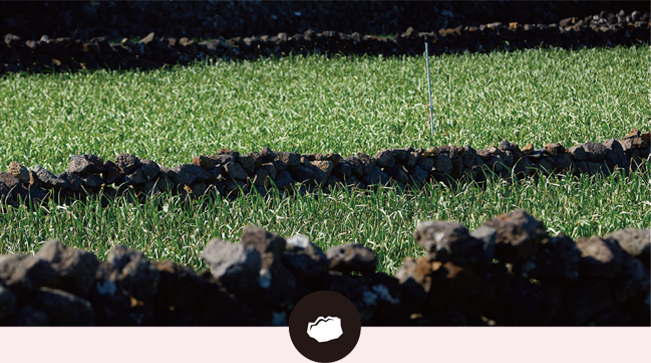
Harmony of Black Basalt and Greenery
When you arrive on Jejudo Island, the first thing you see will be the dol hareubang phallic rock statues carved out of black basalt, and the exotic green palm trees. Wherever you go on Jejudo Island, you will see dark basalt, almost pure black, and green plants surrounded by the volcanic rocks. As Jejudo Island was formed by volcanoes, the entire landscape is formed of basalt, making it the most easily available material for rock statues. The green crops surrounded by basalt walls, and traditional basalt homes with green trees standing in the yard, form the landscape of Jejudo Island. The basalt, which is not exactly black, but a deep brown, close to black, creates a delightful contrast with the green plants, a color combination symbolic of Jejudo Island. All throughout your trip on Jejudo Island, you will see the dark basalt rocks create beautiful harmony with a symphony of colors: yellow, green, orange and emerald green.
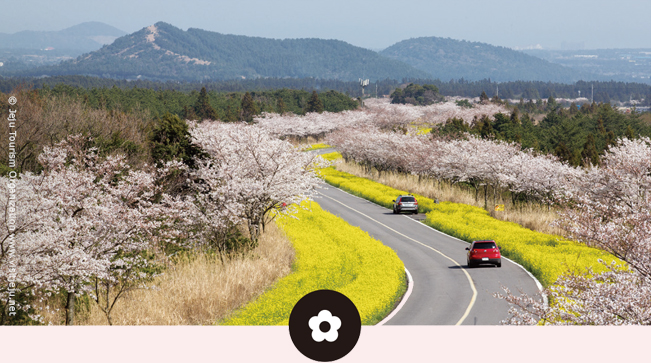
Noksan-ro Canola Blossom Road
Photos taken by tourists on Jejudo Island in the spring will always include yellow canola blossoms. Noksan-ro is a stretch of road famous for its canola blossoms, and a photo spot that's not to be missed in the spring. The road passes through the Noksanjang and Gapmajang pastures, some of the best grazing land on the Korean Peninsula. The road begins at the Seojing horse riding center in Gyorae-ri, Jocheon-eup, passes by the Jeongseok Aviation Museum, and leads to Gasi-ri, Pyoseon-myeon, in Seogwipo, forming a 10 km route for long drives. Once you start along Noksan-ro, the yellow canola blossoms lining the road on both sides fill your eyes, accompanied by the sound of soft classical music. For a brief period, both the canola and cherry blossoms bloom together on some parts of the road, creating a sight not to be missed. This road also claims fame as one of Korea’s official "100 most-beautiful roads." The Jejudo Island Canola Blossom Festival is held each year along Noksan-ro. This year’s will be held from April 7 to 15.
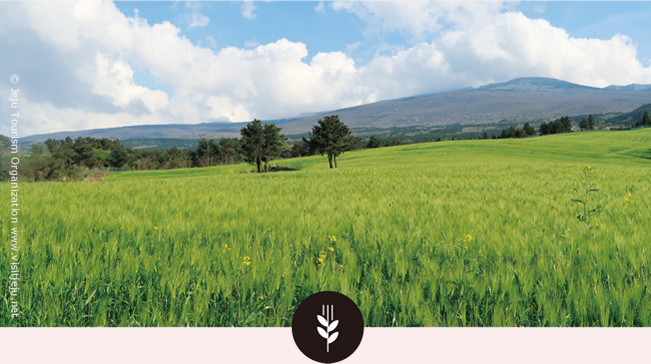
Ora-dong Green Barley Field
April is the best month to see the green barley fields on Jejudo Island. Oradong in Jeju-si rose to fame recently for its green barley fields, which stretch over 0.825 square kilometers (0.32 square miles). Ora-dong offers varied attractions, depending on the season, with buckwheat flowers blooming in the autumn. Gapado Island, just off the coast of the much bigger Jejudo Island, has already established its fame for its green barley fields. Although they are smaller than those in Ora-dong, the entire island is covered in green barley fields. The paths around the island have been designated as an official provincial walking route, which offer beautiful sights of green barley fields surrounded by emerald seas and black basalt.

Orange Carrot Fields of Hado-ri
Each area on Jejudo Island specializes in a different crop. Hado-ri in Gujwa-eup is a carrot-producing area, and carrot fields make up the majority of its land. It's a unique destination, combining carrot farms with interesting sights. Walk through Hado-ri and along Section No. 1 of the official provincial network of walking trails, and you will see piles of large beautiful orange carrots surrounded by black basalt. The clear contrast between these natural colors makes the scenery feel like an oil painting. Alongside Hado-ri, the carrot fields of Jongdal Harbor shouldn't be missed when talking about the colors of Jejudo Island. The green carrot fields surrounded by colorful rooftops and field walls create a sight to behold, set against the deep blue sea.

Travel Tip
-
Jeju Tourism Organization
https://ijto.or.kr
Korean, English, Chinese, Japanese, Vietnamese,Indonesian, Thai, SpanishJeju Tourist Information Center
Tourist Information Desk, 1F, Jeju Welcome Center 23, Seondeok-ro, Jeju-si, Jeju-do
- Information for tourists available at one-stop tourist information desk
Bookings and travel agency services
Tel. +82-64-740-6000 -
Hi Jeju (Jeju Travel Information Portal)
4F, Jeju Welcome Center, 23, Seondeok-ro, Jeju-si, Jeju-do
Tel. 064-742-8861 / Direct line Tel. 064-741-8782Jeju Travel Information
http://www.visitjeju.net/
Korean, English, Chinese, JapaneseSanbangsan Mountain
San16, Sagye-ri, Andeok-myeon, Seogwipo-si, Jeju-do
Tel.+82-64-760-6321 -
Sanbangsan Mountain Tansan Hot Springs
192, Sagyebuk-ro 41beon-gil, Andeok-myeon, Seogwipo-si, Jeju-do
Tel.+82-6464-792-8300- Hours of Operation Indoor hot springs: 6 a.m.-12 a.m. Open-air bath (swimming pool): 11 a.m.-11 p.m. Jjimjilbang: All-day (24 hours)
Other Articles




Jejudo Island

Carpenter and Important Intangible Cultural Property No. 55

A Universe of Their Own

Signpost to Lasting Peace


without the Beef, Please

the Pulse on the Young
Application of subscription
Sign upReaders’ Comments
GoThe event winners
Go


 April 2018
April 2018


